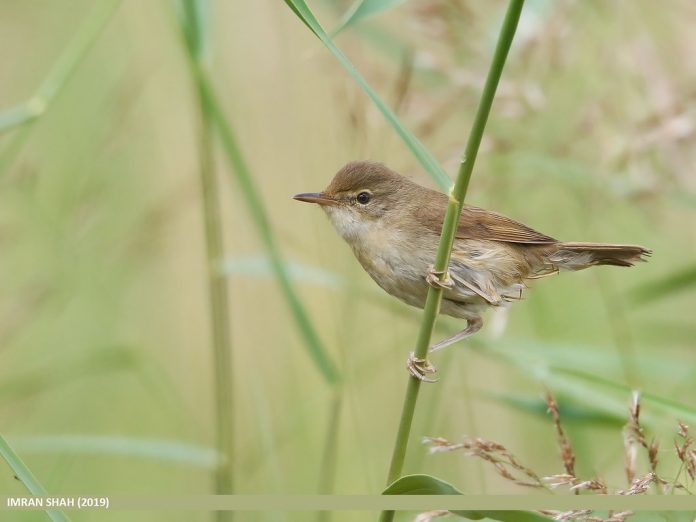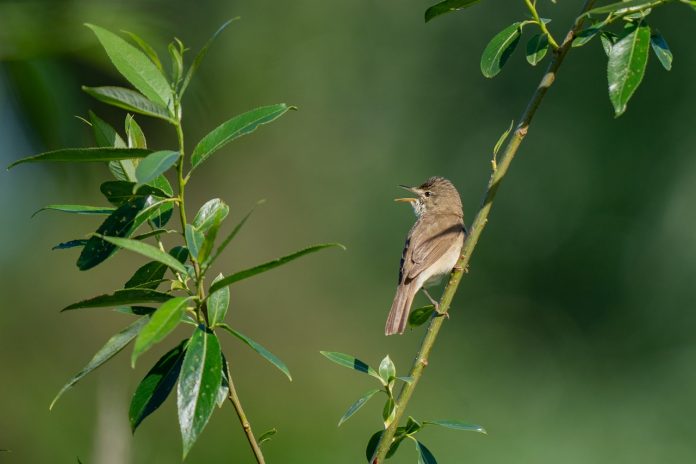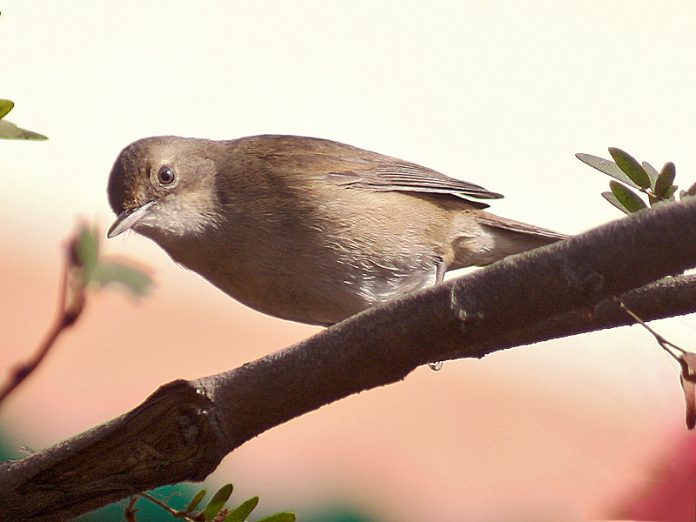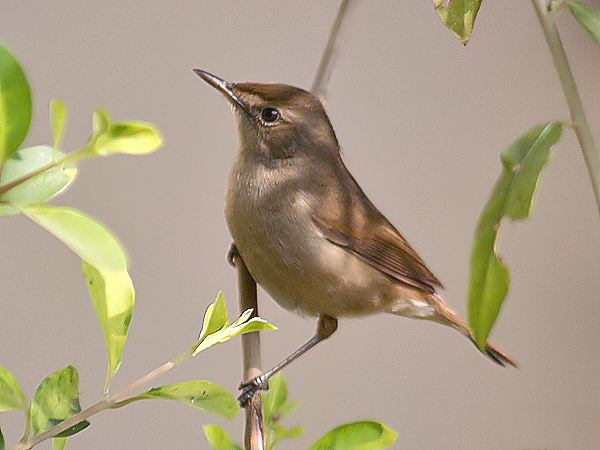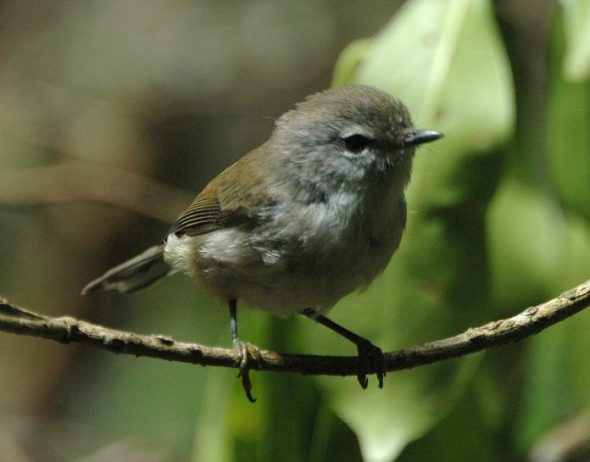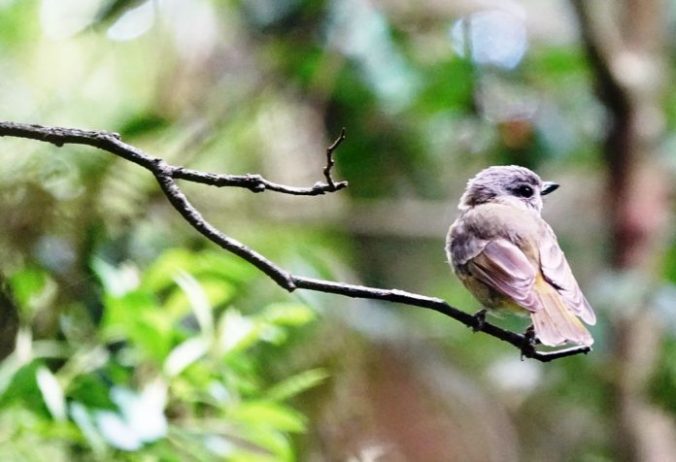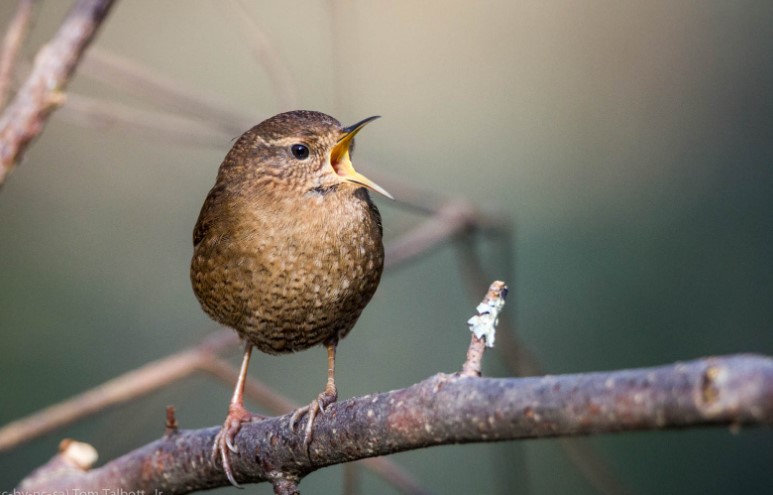Blyth’s Reed Warbler (Acrocephalus dumetorum) is a damp woodland in NE Europe. It is very similar to both Marsh and European Reed Warblers. Blyth’s Reed Warbler is a tree bird by nature, but Marsh and migrant European Reed may also readily be found in trees when habitat availability is limited. It avoids reed beds but occurs side by side with Marsh over much of its breeding range in our region.
The structure generally appears stouter-bodied than European Reed, and the crown is often more peaked, making the bill appear spiky and carried slightly upwards. This, coupled with the often raised tail, sometimes gives a curved overall impression to the bird as it hops through the canopy.
In flight, the relatively short wings can produce a long-tailed impression, which is not usually the case when at rest. The Lesser Whitethroat-like call, which is generously given outside the breeding season, is also a helpful clue to its identity. The relatively short wings and arboreal habitats also recall the Olivaceous Warbler.
Because of the extent of variation through wear and age in Blyth’s Reed and these potential confusion species, structure and calls are important features on which to concentrate when identifying non-singing birds, and some may not be safely separable in the field.
Compared with European Reed: The primary projection is shorter than in European Reed (much shorter than in Marsh); a comparison of primary projection (beyond secondaries) with exposed tertial length shows that Blyth’s Reed Warbler has a primary projection equal to 55–80% of exposed tertial length, whereas in European Reed it is 70–95%.
The legs are usually quite a dark grey, but are sometimes as pale as brownish-pink (especially in juveniles and 1st-winters); the legs of European Reed are rarely as dark as many Blyth’s Reed, being pinkish-brown or grayish-pink, but brighter and paler in juveniles. The claws are dark but yellowish on the inside of the curve, as in European Reed (compare Marsh).
The bill typically appears very dark, with a pale basal area and a dark smudge towards the tip on the lower mandible, but some have a lower mandible that is wholly pale, like European Reed. (Note: the bill pattern suggests Paddyfield Warbler, but the tip of the lower mandible is hardly ever as solidly dark.) Naturally, a colder, duller, more olive or drab grayish-brown bird above than a fresh European Reed (but a worn adult of the latter can look very similar).
However, in fresh plumage in autumn, some 1st-winters are distinctly warm brown above and can recall European Reed in color (especially the dull eastern race fuscus of European Reed). They lack the noticeably contrasting reddish tone to the rump and upper tail coverts of European Reed (although these areas are slightly more rufous-toned in some individual Blyth’s Reed).
The wing feathers (notably tertials) are less strongly dark-centered and pale-fringed than in European Reed in fresh plumage, making the wing appear very uniform, but this character varies with wear and lighting in both species; importantly, alula is dark and quite different in European Reed and indistinct in Blyth’s Reed. The first winters often show a slight contrast on the wing between rufous fringes and the rest of the wing, a feature lacking in European Reed.
Moreover, the throat and breast are usually strikingly whitish, becoming buffish on breast and flanks in fresh plumage (when paler below than European Reed); wears whiter below than typical European Reed when plumage is abraded; and has a greyish tinge to breast sides and flanks (but some worn Reed can look very similar).
Head shows a short, clear white or creamy-white (when fresh) supercilium above lore to just above the eye, usually diffusing immediately after the eye; this is often less obvious and generally more buff in European Reed. In some individuals, the supercilium is more prominent behind the eye than in European Reed (hinting at Paddyfield Warbler, q.v.).
There is a clear whitish eye-ring in Blyth’s Reed that is most apparent under the eye; in Europeans, Reed’s eye-ring is sometimes less obvious, especially under the eye, but maybe prominent enough to predominate over the short supercilium (the reverse of the situation in Blyth’s Reed).
Also, the typical call of Blyth’s Reed is a less whitethroat-like dry ‘tak’; European Reed gives a harsh ‘tcharr’ compared with Marsh: The relatively long, tapering primary projection of Marsh shows reasonably clear pale scaling formed by each primary tip when fresh; this is hardly visible in Blyth’s Reed, which also has a significantly shorter, blunter primary projection.
A comparison of primary projection with the length of the exposed tertials shows that Blyth’s Reed has a primary projection equal to 55–80% of the exposed tertial length; in Marsh, the figure is 75–100%. (In Blyth’s Reed, six primary tips are visible in photographs, compared with eight in Marsh.) Bill is longer in Blyth’s Reed, and his forehead often looks flatter (i.e., more shallowly sloping), accentuating the ‘long-billed’ impression; his facial appearance is less ‘gentle’.
The legs of Marsh are usually paler than those of Blyth’s Reed (or European Reed), especially on 1st-winter birds, which have them typically straw-yellow, compared with blue-grey or brownish-pink in Blyth’s Reed, but some (especially adult) Marsh have pale grayish legs. Claws are dark but yellowish on the inside of the curve; in Marsh, claws are pale pinkish or grayish-brown on both sides.
Bill of Marsh is strikingly pale in the first autumn, with horn-colored culmen and pinkish-yellow lower mandible and sides of the upper mandible, but in adults, the upper mandible is much darker; Blyth’s usually has a very dark bill with lower mandible pale on basal two-thirds, becoming darker towards the tip (but some have wholly pale lower mandible).
In fresh plumage, both species are distinctly olive-brown above, but Marsh is usually paler, becoming almost sandy on the sides of the head and neck, although both can have warmer brown tones, especially on the wing and tail, and lack the contrasting reddish-brown tone to the rump and upper tail coverts of European Reed. When worn, both can look very similar.
The wing feathers (notably tertials) of Blyth’s Reed are less strongly dark-centered and pale-fringed than in Marsh in fresh plumage, but this feature varies with wear and light; alula is usually dark and fairly obvious in Marsh, indistinct in Blyth’s. Throat and breast are usually whiter than in Marsh when the plumage is fresh; the latter often has a pale yellowish-buff wash on the face and throat but wears whitish, especially on the throat, and when worn both species can look very similar below.
However, the head shows a short, clear whitish supercilium above lore to just above the eye, usually diffusing instantly after the eye; supercilium is less obvious and generally buffer in Marsh, often less prominent than pale eye-ring (the reverse of Blyth’s Reed), and indeed many Marsh are virtually plain-headed.
The typical call of Blyth’s Reed is a dry ‘tak’; Marsh gives a softer ‘tuk’, ‘tuk’, but may ‘tak’, ‘tak’ when agitated. Also, it is compared with the Olivaceous Warbler: Olivaceous shares Blyth’s Reed’s arboreal behavior. Upperparts are usually distinctly paler, being dull mouse-brown (lacking any warm tinge), but beware of worn and faded Blyth’s Reed; underparts are a more uniform pale buffish (and there is less contrast between upperparts and underparts than in Blyth’s Reed).
Pale fringes to secondaries often show as a pale panel on the closed wing, lacking in Blyth’s Reed. Bill is much paler and pinker, with merely a horn-colored culmen, and when viewed from below, can be seen to have a much wider base. The tail is fuller, held less firmly closed than in Blyth’s, and usually shows whitishness on the edges and tips of the outermost feathers; it is more square, less rounded, at the tip, and shows a distinct notch; under the tail, coverts are distinctly shorter.
The looser tail is slowly wagged, not held stiffly, as it hops in the canopy. Olivaceous has a rather ‘plain-faced’ appearance with a prominent dark eye typical of Hippolais; although it often shows a narrow pale supercilium above and especially in front of the eye, the lore is pale (contrastingly dusky in Blyth’s Reed). The lower mandible is usually wholly pale (very rarely there is a small, dark tip).
The call is much softer, ‘chuk’, ‘chuk’, recalling that of Marsh. In the hand, the wings are 58–67 mm (64–74 mm in Marsh, 61–71 mm in European Reed). 2nd primary =6 and notch very long, reaching secondaries, although may only reach 10th primary in juvenile/1st-winter (2nd primary =4/5 in European Reed and Marsh, and notch shorter, reaching 7th or 8th primary in Marsh and 9th primary in European Reed).
In autumn, adults have worn flight and tail feathers when whole plumage is fresh in the first-winters. Blyth’s Reed Warbler is most commonly called a frequently repeated, hard, short ‘chek’ or ‘tak’ resembling that of Lesser Whitethroat, although a short, harsh ‘tchirr’ (recalling Sedge Warbler) may also be given when agitated.
Blyth’s Reed Warbler song is typically acrocephaline and includes much mimicry, although distinctly slower, more ponderous, and less vigorous in delivery than in Marsh Warbler, with more whistles (including a characteristic rising ‘chu-eeloo’); most phrases repeated 5–8 times in succession, with distinct pauses (and often one or two hard tongue-clicking sounds) between each phrase, quite different from the hurried and increasingly frantic delivery of Marsh Warbler.
The song is delivered from within the canopy of a small tree or large bush or from an exposed perch at mid-level, mostly between dusk and dawn. The hybrid’s interbreeding with Marsh Warbler appears to be fairly frequent, and offspring show intermediate characters, complicating the identification issue further.
Blyth’s Reed Warbler is common and migrates southeast to winter in Southeast Asia. (In addition to the mapped range, has bred Sweden and Lithuania.) Inbreeding season favors damp broadleaved woodland, including edges and glades, wooded gullies, parks, and large gardens; also thickets in both wet and dry terrain, including coniferous forest. Outside breeding season, in trees and shrubs, both in wet and dry situations,.
Related Reading: Arctic Warbler
